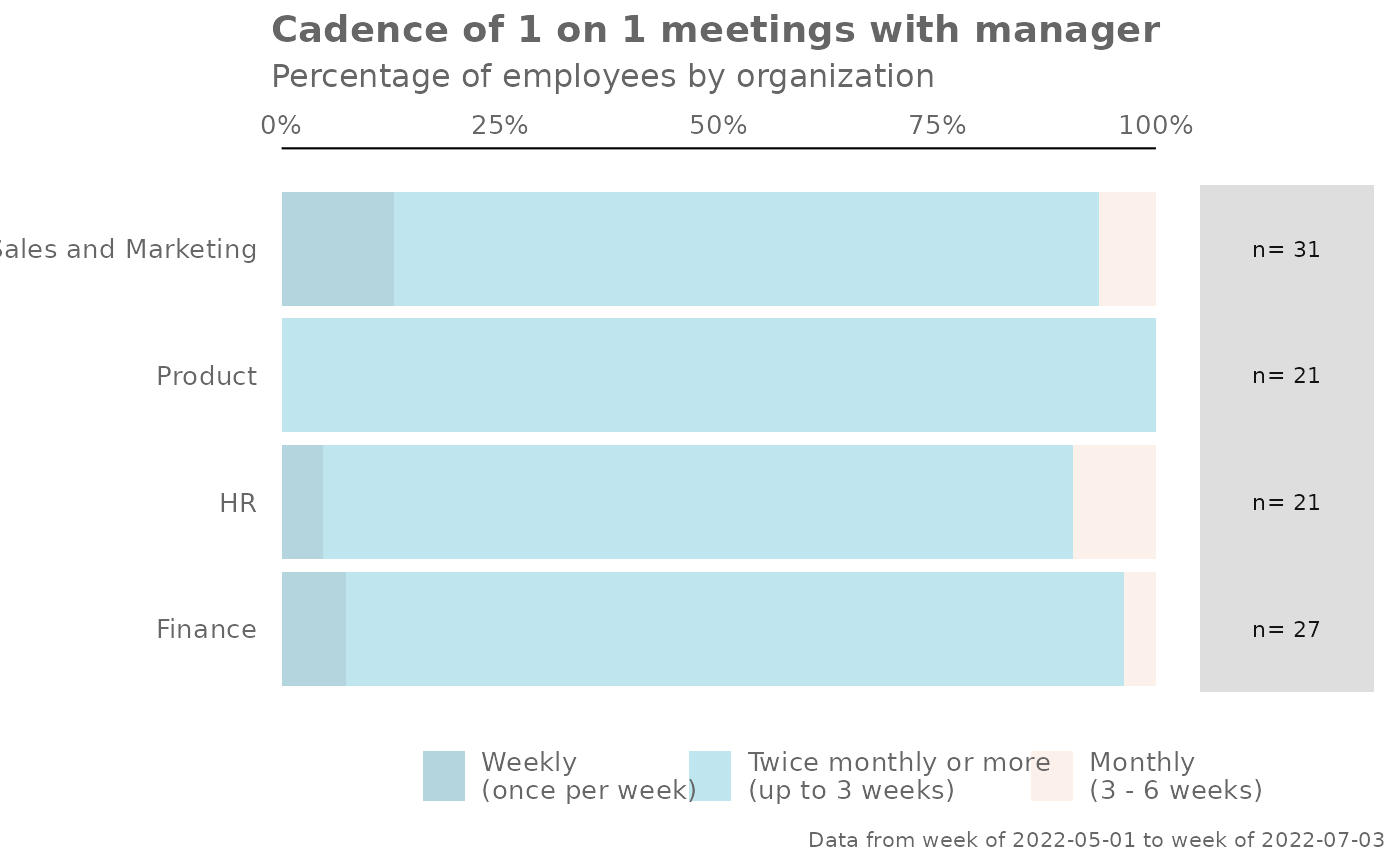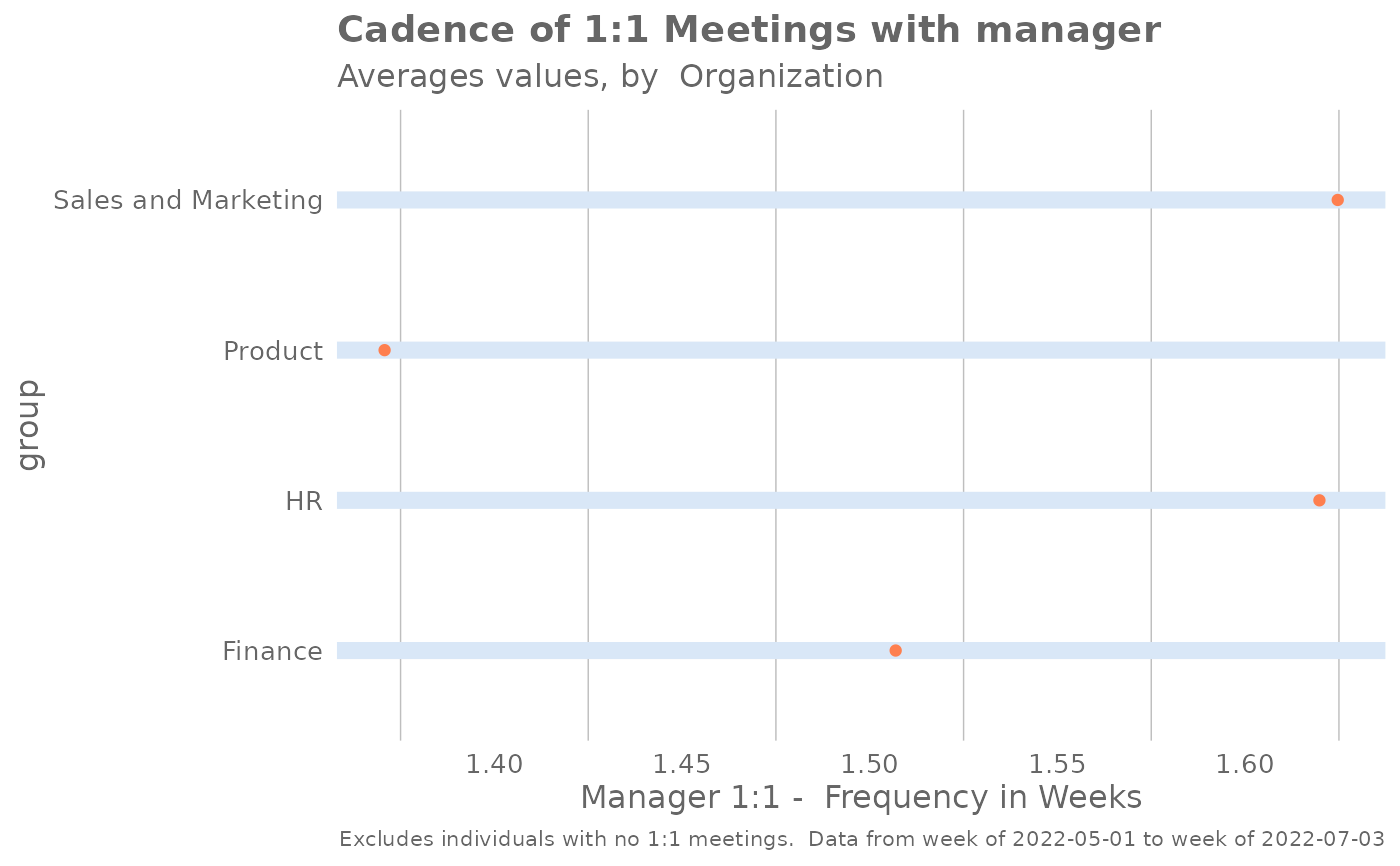
Frequency of Manager 1:1 Meetings as bar or 100% stacked bar chart
Source:R/one2one_freq.R
one2one_freq.RdThis function calculates the average number of weeks (cadence) between of 1:1 meetings between an employee and their manager. Returns a distribution plot for typical cadence of 1:1 meetings. Additional options available to return a bar plot, tables, or a data frame with a cadence of 1 on 1 meetings metric.
Usage
one2one_freq(
data,
hrvar = "Organization",
mingroup = 5,
return = "plot",
mode = "dist",
sort_by = NULL
)Arguments
- data
A Standard Person Query dataset in the form of a data frame.
- hrvar
String containing the name of the HR Variable by which to split metrics. Defaults to
"Organization". To run the analysis on the total instead of splitting by an HR attribute, supplyNULL(without quotes).- mingroup
Numeric value setting the privacy threshold / minimum group size. Defaults to 5.
- return
String specifying what to return. This must be one of the following strings:
"plot""table"
- mode
String specifying what method to use. This must be one of the following strings:
"dist""sum"
- sort_by
String to specify the bucket label to sort by. Defaults to
NULL(no sorting).
Value
A different output is returned depending on the value passed to the return argument:
"plot": 'ggplot' object. A stacked bar plot for the metric."table": data frame. A summary table for the metric.
Distribution view
For this view, there are four categories of cadence:
Weekly (once per week)
Twice monthly or more (up to 3 weeks)
Monthly (3 - 6 weeks)
Every two months (6 - 10 weeks)
Quarterly or less (> 10 weeks)
In the occasion there are zero 1:1 meetings with managers, this is included
into the last category, i.e. 'Quarterly or less'. Note that when mode is
set to "sum", these rows are simply excluded from the calculation.
See also
Other Visualization:
afterhours_dist(),
afterhours_fizz(),
afterhours_line(),
afterhours_rank(),
afterhours_summary(),
afterhours_trend(),
collaboration_area(),
collaboration_dist(),
collaboration_fizz(),
collaboration_line(),
collaboration_rank(),
collaboration_sum(),
collaboration_trend(),
create_bar(),
create_bar_asis(),
create_boxplot(),
create_bubble(),
create_dist(),
create_fizz(),
create_inc(),
create_line(),
create_line_asis(),
create_period_scatter(),
create_rank(),
create_rogers(),
create_sankey(),
create_scatter(),
create_stacked(),
create_tracking(),
create_trend(),
email_dist(),
email_fizz(),
email_line(),
email_rank(),
email_summary(),
email_trend(),
external_dist(),
external_fizz(),
external_line(),
external_rank(),
external_sum(),
hr_trend(),
hrvar_count(),
hrvar_trend(),
keymetrics_scan(),
meeting_dist(),
meeting_fizz(),
meeting_line(),
meeting_rank(),
meeting_summary(),
meeting_trend(),
one2one_dist(),
one2one_fizz(),
one2one_line(),
one2one_rank(),
one2one_sum(),
one2one_trend()
Other Managerial Relations:
one2one_dist(),
one2one_fizz(),
one2one_line(),
one2one_rank(),
one2one_sum(),
one2one_trend()
Examples
# Return plot, mode dist
one2one_freq(pq_data, hrvar = "Organization", return = "plot", mode = "dist")
 # Return plot, mode sum
one2one_freq(pq_data,
hrvar = "Organization",
return = "plot",
mode = "sum")
# Return plot, mode sum
one2one_freq(pq_data,
hrvar = "Organization",
return = "plot",
mode = "sum")
 # Return summary table
one2one_freq(pq_data, hrvar = "Organization", return = "table")
#> # A tibble: 7 × 3
#> group `Weekly\n(once per week)` Employee_Count
#> <fct> <dbl> <int>
#> 1 Finance 1 68
#> 2 HR 1 33
#> 3 IT 1 68
#> 4 Legal 1 44
#> 5 Operations 1 22
#> 6 Research 1 52
#> 7 Sales 1 13
# Return summary table
one2one_freq(pq_data, hrvar = "Organization", return = "table")
#> # A tibble: 7 × 3
#> group `Weekly\n(once per week)` Employee_Count
#> <fct> <dbl> <int>
#> 1 Finance 1 68
#> 2 HR 1 33
#> 3 IT 1 68
#> 4 Legal 1 44
#> 5 Operations 1 22
#> 6 Research 1 52
#> 7 Sales 1 13